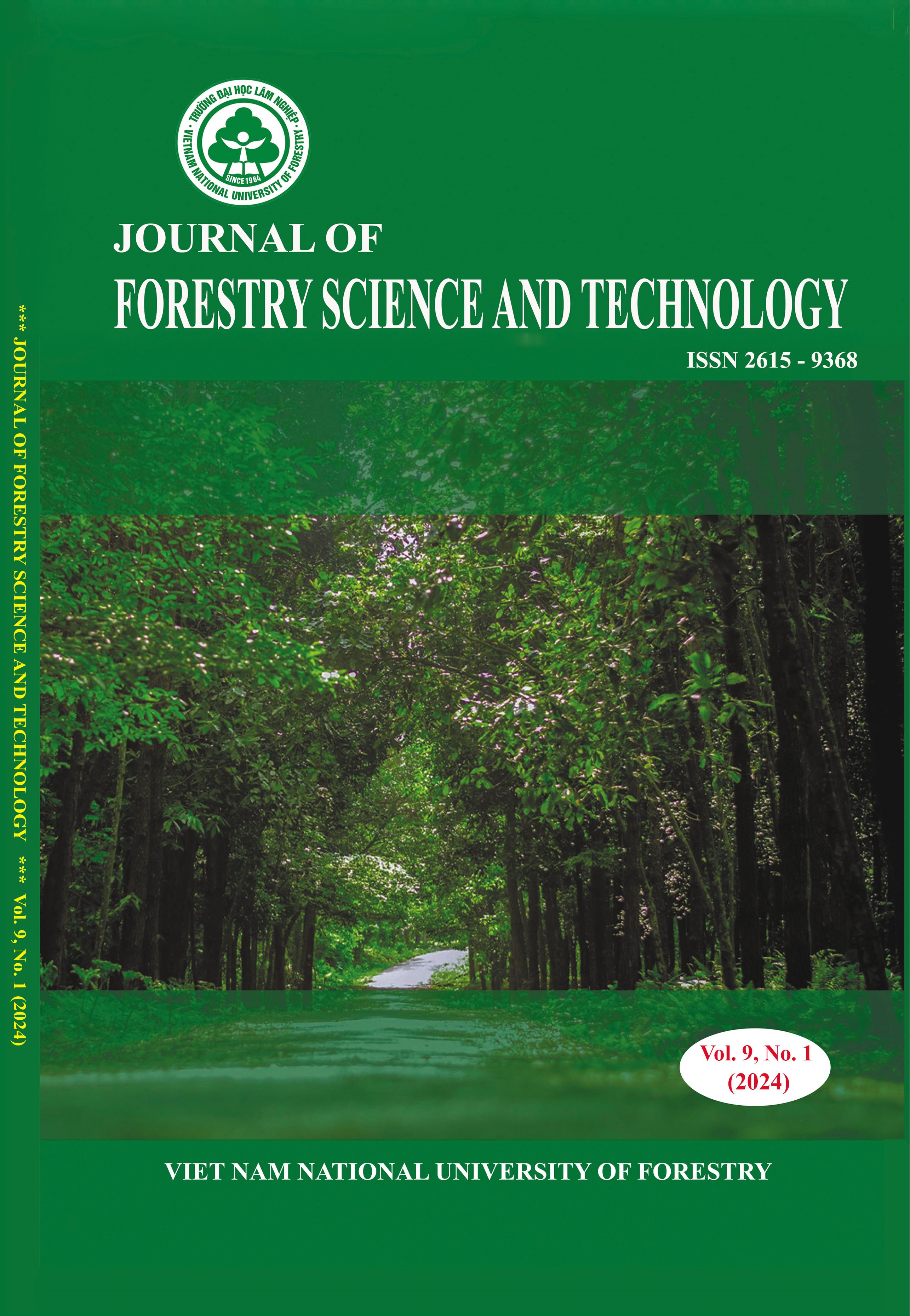Assessing environmental services and economic values of urban tree species in open public green spaces at Ecopark, Hung Yen province, Vietnam: An application of i-Tree Eco model
DOI:
https://doi.org/10.55250/Jo.vnuf.9.1.2024.086-095Keywords:
Economic benefit, enviromental services, i-Tree Eco, urban tree, VietnamAbstract
Urban trees have been widely acknowledged providing a wide range of environmental services. They help to improve air quality by absorbing pollutants, crucial roles in magaging stormwater runoff etc., in urban environments. This study applied i-Tree Eco model to assess the structure of community trees and quantifies the environmental services and economic values in open public green spaces in Eco Park, Hung Yen province, Vietnam. To run the model, we collected profiles of 942 trees in the study area, including: location; species name; diameter at beast height (DBH, 1.3 m above ground); tree height values (crown tree height, canopy length, etc.); height under canopy (canopy width of East-West, South-North directions); canopy missing percentage; and crown light exposure. The result showed that all the tree species contributed to 990kg PM2.5 reduction (equal to 231,702 $/year); 1,338.4 (ton/year) carbon sequestration (equal to 13,384 $/year) and 26,772.1 (ton) carbon storage; and 37,600.2 (m3) avoided runoff (equal to 79,712 $/year). Overall, Khaya senegalensis (Desr.) A. Juss. species was providing the most environmental services; Ficus subpisocarpa Gagnep. species was the most economically valuable with nearly 75 $/tree. Urban landscape design should consider these superior tree species into green infrustructure projects to maximize the environmental services and economic values.
References
. Hongyu Zhao, Dongliang Zhao, Xue Jiang, Shiyu Zhang & Zhanlue. Forests Lin (2023). Assessment of Urban Forest Ecological Benefit Based on the i-Tree Eco Model—A Case Study of Changchun Central City. 14(7): 1304.
. Robert C. Coville, James Kruegler, William R. Selbig, Satoshi Hirabayashi, Steven P. Loheide, William Avery, William Shuster, Ralph Haefner, Bryant C. Scharenbroch, Theodore A. Endreny & David J. Nowak (2022). Loss of street trees predicted to cause 6000 L/tree increase in leaf-on stormwater runoff for Great Lakes urban sewershed. Urban Forestry & Urban Greening. 74: 127649.
. Yeganeh Yousofpour, Leili Abolhassani, Satoshi Hirabayashi, Diane Burgess, Mahmood Sabouhi Sabouni & Mahmoud Daneshvarkakhki (2024). Ecosystem services and economic values provided by urban park trees in the air polluted city of Mashhad. Sustainable Cities and Society. 101: 105110.
. Marzena Suchocka, Jakub Heciak, Magdalena Błaszczyk, Joanna Adamczyk, Marek Gaworski, Agnieszka Gawłowska, Jacek Mojski, Hazem M. Kalaji, Karolina Kais, Joanna Kosno-Jończy & Magdalena Wojnowska Heciak (2023). Comparison of Ecosystem Services and Replacement Value calculations performed for urban trees. Ecosystem Services. 63: 101553.
. Tran Thu Trang, Nguyen Dang Khoa, Do Minh Truyen & Vu Thi Quyen (2022). Evaluation of the role of trees in removing air pollutants at selected universities in Ho Chi Minh City: Using i-Tree Eco model. TNU Journal of Science Technology. 227(15): 117-129.
. Tran Ngoc Son, Hoang Van Chuong, Nguyen Tuong Vi, Nguyen Van Linh, Ha Minh Hieu & Doan Chi Cuong (2023). Aassessment of ecosystem services based on i-Tree Eco model in the 29/3 Park, Danang city. Environment Magazine (English edition). 2: 61-64.
. Tran Ngoc Son, Ha Minh Hieu, Vo Van Minh & Hoang Van Chuong (2022). Using the I-Tree Eco model to evaluate structure, benefits and value of street trees in Thanh Khe district, Da Nang city. Environment Magazine. 4: 61-64.
. Ting Wei, Junliang Wu & Shaoqing Chen (2021). Keeping track of greenhouse gas emission reduction progress and targets in 167 cities worldwide. Frontiers in Sustainable Cities. 3: 696381.
. David J. Nowak, Daniel E. Crane, Jack C. Stevens, Robert E. Hoehn, Jeffrey T. Walton & Jerry. Bond (2008). A ground-based method of assessing urban forest structure and ecosystem services. Arboriculture & Urban Forestry. 34(6): 347-358.
. David J. Nowak & Daniel E. Crane (2002). Carbon storage and sequestration by urban trees in the USA. Environmental Pollution. 116(3): 381-389.
. David J Nowak (2021). Understanding i-Tree: 2021 summary of programs and methods. US Department of Agriculture, Forest Service, Northern Research Station.
. David J Nowak, Scott Maco & Mike Binkley (2018). i-Tree: Global tools to assess tree benefits and risks to improve forest management.
. Xueyan Wang, Jing Yao, Shuai Yu, Chunping Miao, Wei Chen & Xingyuan He (2018). Street Trees in a Chinese Forest City: Structure, Benefits and Costs. Sustainability. 10(3).
. David J. Nowak, Satoshi Hirabayashi, Allison Bodine & Robert Hoehn (2013). Modeled PM2.5 removal by trees in ten U.S. cities and associated health effects. Environmental Pollution. 178: 395-402.
. J. Yang, J. McBride, J. Zhou & Z. Sun. (2005). The urban forest in Beijing and its role in air pollution reduction. Urban Forestry & Urban Greening. 3(2): 65-78.
. C. Liu & X. Li. (2012). Carbon storage and sequestration by urban forests in Shenyang, China. Urban Forestry & Urban Greening. 11(2): 121-128.
. Levente J Klein, Wang Zhou & Conrad M Albrecht (2021). Quantification of carbon sequestration in urban forests. International Conference on Machine Learning. arXiv.









